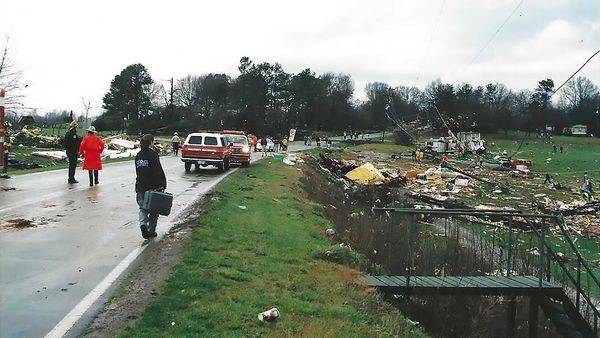The pre-dawn darkness on March 20, 1998 started much like any other for people in Hall and White counties.
They were up and about, getting ready for work. Parents were getting their kids out of bed, getting them ready for another school day. But, in just a matter of minutes, the day turned into anything but just another spring day.
A LOOK BACK – 26 YEARS LATER
For out of the darkness, from the west, came a tornado. And, when all was said and done, 12 of their neighbors and a sheriff’s deputy from another county would be dead. Scores would be injured. And there would be millions of dollars in damage left behind to homes, businesses and schools.
The first indication that anything was wrong came about 6:30 with reports of an “officer down” west of Gainesville.
It turned out that the officer – a Dawson County sheriff’s deputy – was the first victim of the storm. She was killed when she was hit by a car after she stopped to help a motorist involved in a weather-related accident.
AND THEN
From there, the storm skipped farther into Hall County, heavily damaging Lanier Elementary School near Murrayville and killing a deliveryman as it tore across the school grounds. A few seconds later, North Hall High School was hit. It, too, suffered heavy damage.
The Hall County School System did not fully recover from the storm until the fall of that year and the start of a new school year. For the remainder of the term, some Lanier Elementary students attended classes at Sardis and Wauka Mountain elementary schools and even at Northlake Church, which is across the street from Lanier.
At North Hall, portable partitions were brought in and the gym floor was turned into temporary classrooms. In addition, a system was devised whereby classrooms at the high school were used for classes during those times of the day when they were normally used by teachers for planning purposes.
The twister left the North Hall area and moved into White County where several people were injured, one of them fatally.
SINCE THEN
Since the storm a lot has changed in Hall County and the rest of the state in the way the public is alerted to severe weather advisories and warnings. Radio and television still play a big part in getting the word out. But now there’s the Internet, through which messages can be instantly transmitted to computers, iPADs, SmartPhones, etc. Social media – Facebook, Twitter, etc. – are also available. In addition, the Georgia Emergency Management Agency (GEMA) and the National Weather Service, within five years of the tornado, implemented a number of measures that were designed to improve things.
Five years after the storm, in 2003, a county-wide siren warning system had been installed in Hall County and a new weather radio transmitter had been installed on Wauka Mountain on the Hall-White County line covers all of the county.
In addition, the National Weather Service has improved its ability to spot problems on radar and get the word out.
STATE AND FEDERAL HELP
The state and federal governments quickly mobilized to send help to the devastated areas – and James Witt, then the head of the U.S. Emergency Management Agency – personally surveyed the damage in the days after the storm. Then-President Bill Clinton quickly issued a federal disaster declaration, making those whose homes and businesses that were damaged or destroyed eligible for low-interest loans to help in the rebuilding or repairing and to expedite the use of federal resources in the clean-up.
Within hours and days, shelters had been set up for the homeless. Food, clothing and building materials began rolling into the area from all over the state. Special blood drives were held to help replenish supplies left short by blood used to help treat those who had been injured. Special accommodations were made to get prescription drugs to those who had lost theirs during the storm.
WEATHER SERVICE REPORT
A report issued by the National Weather Service (NWS) two months after the twister concluded that it traveled 11.5 miles through northern Hall County into southern White County. Its path was up to one-quarter of a mile wide.
In its wake,12 fatalities were directly related to the tornado, the report said. Eleven of them occurred in mobile homes. Eleven of them were in Hall County, with the remaining one in White County. One additional indirect fatality occurred: the sheriff’s deputy who had stopped to help with a weather-related traffic accident and was hit by a passing car and killed.
Hall County reported 96 injuries, while White County reported 75.
In Hall County, according to the NWS report, 30 homes were destroyed with 105 damaged. Damages in Hall County were estimated at around $13.5 million (in 1998 dollars). Damage in White County was estimated at $1.7 million, with 22 homes destroyed and nine damaged. Thirteen mobile homes were destroyed, with nine damaged.
(Though not included in the NWS report, several poultry farms were also in the path of the storm and a number of poultry houses were flattened by the winds. Thousands of chickens were killed. A number of cattle was also killed).
The report goes on to say, “one of the main concerns about this tragedy was the lack of a warning from the Peachtree City (NWS) office prior to the onset of the tornado. A severe thunderstorm watch for the area had been issued at 12:45 a.m. but was allowed to expire, as scheduled, at 6:00 a.m. A severe thunderstorm warning was issued for Hall County at 6:46 a.m., about 20 minutes after the tornado struck and about the time the NWS began receiving first reports that the twister had touched down. Because of those reports, a tornado warning was posted at 6:51 for White County.”
HISTORY
This was not the first time Hall County had been struck by a killer tornado.
On April 6, 1936, a storm leveled the downtown area, killing 203 people and injuring 1,600. It, too, struck in the morning, when many people were on their way to work or school or had just arrived there. Some reports said debris was stacked 10-feet deep in the street. Fires broke out. The highest number of fatalities in a single building occurred at the Cooper Pants Factory, where 70 people lost their lives.
A tornado that hit Gainesville in 1903 killed about 100 people and caused damages placed at $750,000 in 1903 dollars.
For information about tornadoes and tornado safety tips, go the Web site listed below.
U.S Storm Prediction Center. http://www.spc.noaa.gov/faq/tornado/safety.html
(Pictures courtesy Hall County Fire Department, now Hall County Fire Rescue)







